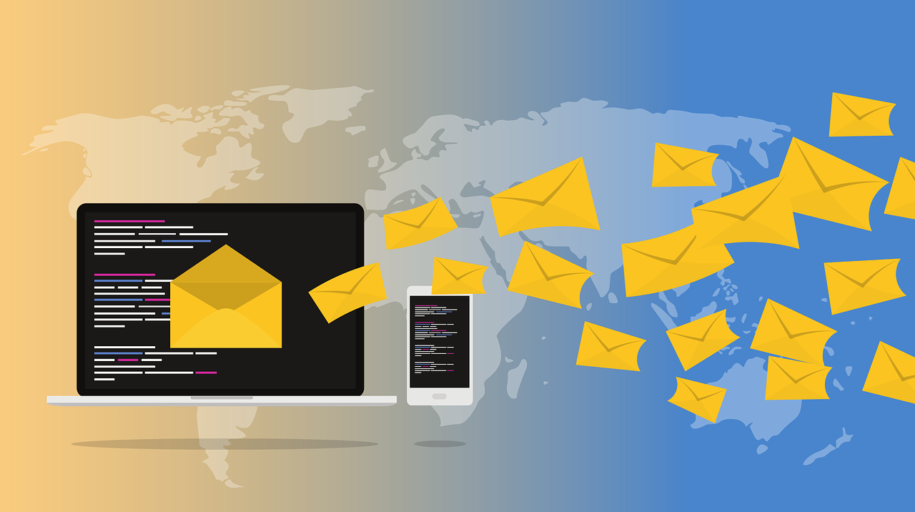Email protocol in a nutshell
There are significant email protocols that you should know before constructing email campaigns. These protocols are SMTP, POP, and IMAP protocol.
If you are a business owner or a marketer, it’s absolutely useful to know the distinctions between SMTP, POP3, IMAP4, and their functions in the operation of sending emails.
In this article, we would like to share some practical information regarding email protocols in a comprehensive way.
Let’s get started with the term “email infrastructure” and its importance.
What does Email infrastructure mean?
Email infrastructure is a procedure that consists of a few elements like:
- Domain Name System (DNS)
- Internet Protocol (IP) addresses
- Mail Transfer Agents (MTA)
The ultimate part of each of them is to guarantee smooth email transmission.
That means, it is their part to transmit every newsletter and/or transactional emails you send out.
What’s the significance of email protocols?
The email transfer process can be basically described with this order:
1- A sender sends an email
2- A mail server handles the delivery
3- A recipient receives the email
When we approach this subject from the infrastructure window, we can fundamentally say that email protocols establish the connection between all those 3 elements altogether.
However, when we think about it as a customer, we can just say that they do the job they’re supposed to do as it’s their responsibility.
Email protocols are absolutely essential for maintaining email deliverability healthy. They work alongside processes like email authentication, spam scoring, and blacklisting to make it happen.
SMTP Protocol
SMTP stands for Simple Mail Transfer protocol which is responsible for transmitting emails in the Transmission Control Protocol / Internet Protocol suite model (TCP/IP). MTAs use this method in order to transmit messages between the servers.
SMTP adopts a command-based functionality. There are basic commands like HELO, MAIL, FROM, and many others.
SMTP commands are used to specify the sender, the receivers, and the message itself. Also, SMTP commands establish the connection between email servers.
This protocol monitors the frequency of sending to avoid the email flood in a recipient’s inbox.
SMTP Ports
When it comes to email infrastructure, ports are responsible for how email proceeds through the network. For instance, they can go through a general path, through an encrypted path, and so on.
There are 4 SMTP ports:
- Port 25: An old school port, but some email clients block it due to low-security
- Port 465: A port for SMTPS (secured), but now it’s rarely used
- Port 587: A common encrypted and secured port used by all email clients
- Port 2525: A secured and modern version of port 25; many consider it the best option
It may look complicated but there’s no need to worry about that as most email clients and marketing automation services have already configured the SMTP protocol and encrypted ports.
However, If you’d like to set up SMTP protocols, you should fill in all the SMTP credentials in the mail client settings and choose a port.
Data privacy and cybersecurity are significant subjects. Therefore, it’s better to use contemporary SMTP ports with encryption and additional security layers to prevent data breaches and leakages, and other kinds of cybercrime.
POP
Post Office Protocol (POP) is an inbound email protocol. POP3 is the third version of it which is the most popular one. This protocol is used to retrieve emails from the server and send them to the recipients’ inboxes. POP3 is the standard for receiving e-mails.
Its process is also simple: after you send a transactional email, SMTP takes over the sending part. POP3 reaches the mail server, takes the message, and forwards it to the recipient’s inbox.
The crucial detail and difference with POP3 is that it downloads the messages and immediately deletes them from the server. This is the biggest advantage of POP3 – it does not rely on an Internet connection when downloading the message; you can reach it even if you’re are offline.
However, the biggest disadvantage is that you can not access the same email from different devices, as it can only be downloaded from one device.
POP3 has 2 ports:
- Port 101: A default port
- Port 995: A secured and encrypted option
As you might assume, the second one is preferable in 2022.
IMAP
IMAP stands for Internet Message Access Protocol. IMAP is the second inbound email protocol.
Currently, IMAP4 (4th version) is the most commonly used version. Its main task is to bring e-mails from the server to the inboxes. However, IMAP4 does not delete emails from the server as POP3 does. It allows you to access your emails from different devices.
The functionality of IMAP is command-driven and based on these 3 steps:
1. When you receive a new email, your email client connects to the server.
2. A message preview is activated where you can see the email subject line and the sender name of the email.
3. After you open the email, it will be downloaded using IMAP.
As for the ports, IMAP4 provides:
– Port 143: The default port
– Port 993: Known as IMAP, this is a secured port preferred by email clients.
Overall, IMAP4 has become an efficient solution for teams that manage multiple email inboxes and need synchronization between multiple devices, which is quite common these days.
POP vs. IMAP
When comparing POP3 and IMAP4, keep in mind that most modern email clients support both protocols. Also, both protocols have TLS/SSL encrypted ports enabled.
When it comes to the Internet connection, POP3 is the winner. IMAP4, on the other hand, depends heavily on a good connection and the uninterrupted work of the servers.
Which e-mail protocol you should choose?
Now you know that there is one protocol for sending emails (SMTP) and two protocols for receiving emails (POP3 and IMAP4).
If you are trying out a new email marketing tool, an automation or testing solution, or just want to configure an email client for privacy, here is what port you should choose.
SMTP should be your choice because it is the only protocol for sending emails. It is an essential component of your email infrastructure – without it, you would not be able to send transactional or marketing emails. So, your task is to choose the most suitable SMTP port. As mentioned earlier, we’d recommend you to prefer encrypted ports over standard ones.
When it comes to receiving protocols, implementing two protocols is the best option for you. However, for small teams or one-person companies, you can also use POP3. This protocol is well-suited for companies that place great emphasis on security and privacy, as emails are not stored on servers once they are opened. If you do not need to check your email all the time, you might consider this protocol – you’ll have a single inbox with exclusive access.
IMAP4 is the protocol of choice for growing teams and large organizations that value fast delivery and accessibility. This protocol works well for shared inboxes and activities that focus on replies. Consider this protocol if your focus is on response time.
Summary
Email protocols are considered a technical topic, but it is essential knowledge that will help you better understand how sending and receiving email works.
To summarise, SMTP is essential for sending emails. POP3 helps you receive emails and provides more privacy in this process. And finally, IMAP4 meets the modern pace of accessibility.


